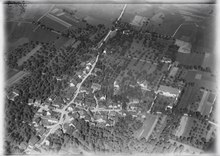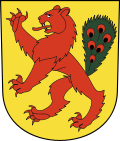Fällanden
| Fällanden | |
|---|---|
| State : |
|
| Canton : |
|
| District : | Uster |
| BFS no. : | 0193 |
| Postal code : | 8117 Fällanden 8118 Pfaffhausen 8121 Benglen |
| Coordinates : | 690 736 / 247484 |
| Height : | 453 m above sea level M. |
| Height range : | 434–643 m above sea level M. |
| Area : | 6.38 km² |
| Residents: | 8672 (December 31, 2018) |
| Population density : | 1359 inhabitants per km² |
|
Proportion of foreigners : (residents without citizenship ) |
24.0% (December 31, 2018) |
| Mayor : | Tobias Diener ( FDP ) |
| Website: | www.faellanden.ch |
|
Fällanden Church |
|
| Location of the municipality | |
Fällanden is a municipality in the district of Uster in the canton of Zurich in Switzerland . The community includes the village of Fällanden and the former court settlements of Benglen , Pfaffhausen and Neuhausen .

geography
The agglomeration community lies between the northeastern slope of the Pfannenstiel chain and the northwestern bank of the Greifensee .
The center of Fällanden is at the foot of the hill ( 453 m ), where the traffic routes Dübendorf - Maur and Schwerzenbach - Zurich cross. From there the place has expanded into the flat Glatt valley , but also up the slope.
Benglen and Pfaffhausen, today larger villages, are located on terraces around 150 meters above the village.
The Jörentobel (also Fällandertobel) with a large erratic block swarm made of rock from the Glarus Alps is part of the federal inventory of landscapes and natural monuments of national importance .
history
Archaeological excavations show Mesolithic residential areas as well as Neolithic and Bronze Age settlement areas in the Greifensee area to below the present-day village. Fällanden is first mentioned as Fenichlanda around 820. In the 9th / 10th In the 18th century, the Fraumünster owned large estates, while the Grossmünster received large parts of the tithe. The property of the Fraumünster was administered by the Mülner as a fief from a local Kehlhof at the latest since 1250 . The bailiwick rights were with the Counts of Rapperswil until 1300 and came to Zurich with the rule of Greifensee in 1402.
coat of arms
- In gold a soaring red lion, tailed with a green peacock bump.
The community bears the coat of arms of the Aeppli family from Zurich. The seal of Heinrich Aeppli, adorned with the lion, who was Vogt of Greifensee in 1421 and acquired the castle stables and the courts of Maur in 1424, can be found on documents from 1422 and 1439. The Aeppli von Fällanden coat of arms is the red lion with peacock tail, the may point to relations with Austria, in Gerold Edlibach's coat of arms book (1493), anonymous from 1531, in the chronicle of Johannes Stumpf (1547/48) and in the gender book of Johann Friedrich Meiss (1740). Hans Konrad Gyger was one of the first to use the Aeppli coat of arms as a heraldic symbol of the village of Fällanden in his Zurich map from 1667. In the 19th century, the lion turned to the right was placed in the seal of the municipal council office, and since 1884 it has adorned a pane of the church. On December 18, 1926, the local council recognized the Aeppli coat of arms as the official coat of arms of Fällanden.
population
| Population development | |
|---|---|
| year | Residents |
| 1634 | 284 |
| 1799 | 632 |
| 1850 | 848 |
| 1900 | 696 |
| 1950 | 866 |
| 1970 | 4,260 |
| 1990 | 6,489 |
| 2000 | 6'423 |
| 2007 | 7,177 |
| 2010 | 7,971 |
While 6,707 people lived in the community at the end of 2003, on December 31, 2004 there were already 6,928 inhabitants (3,525 women and 3,403 men). The population has increased by 3.3% within a year. At the end of 2004, a total of 5,723 Swiss (82.8%) and 1,196 foreigners (17.2%) were registered in the municipality. At the end of 2004, 3,156 (+ 10%) people lived in the Fällanden part of the village, 1,946 (+ 0.75%) in Benglen and 1,826 (+ 3%) in Pfaffhausen. As of December 31, 2007, 7,177 people had their civil law residence in the municipality. This corresponds to an increase of 4% compared to the previous year. In the three parts of the municipality Fällanden has 3,305, Benglen 1,893 and Pfaffhausen 525 inhabitants.
politics
The strongest party in the municipality is the SVP, which has had a share of 30.79% of the vote since the last National Council elections. It is followed by the SP with 18.35%, the FDP with 17.05%, the GLP with 11.15%, the CVP 8.9% and the Greens 8.5%.
| Members of the Fällander Municipal Council ( term of office 2018–2022) | |||
|---|---|---|---|
| Surname | Taking office | function | Political party |
| Tobias Diener | 2010/2018 | Parish President, Head of Presidential Affairs | FDP |
| Ruedi Maurer | 2015 | Head of Population and Security, Vice-President | independent |
| Maia Ernst | 2010 | Head of Society | GLP |
| Pierre-André Schärer | 2014 | Head of Building Construction | independent |
| Rita Niederöst | 2019 | Head of Real Estate Department | SP |
| Chris Rossmann | 2019 | Head of Finance and Taxes | FDP |
| Thomas Bürki | 2014 | Head of Civil Engineering and Works | independent |
economy
Important branches of business are agriculture, hospitality and small businesses. Axpo AG and the power station of the city of Zurich maintain a substation for electricity on Dübendorfstrasse . This is where the 380 kV Sils-Fällanden line ends , which also passes through the hamlet of Benglen.
Buildings
Attractions
- In the “Stocklen” area, renaturation to a wetland began in August 2019 .
Personalities
- Albert Meyer (1870–1953), Federal Councilor
- Alex Eugster , singer, entrepreneur and record producer
- Kurt Baebi , musician, composer
- Heidi Bruggmann , professional musician
- Marc Sway , musician
- Johann Rudolf Wolf (1816–1893), astronomer.
literature
- Hans Martin Gubler: Art Monuments of Switzerland Volume 66 "The Art Monuments of the Canton of Zurich Volume 3: The Districts Pfäffikon and Uster" Society for Swiss Art History GSK Bern 1978, ISBN 3-7643-0991-1 , pp. 605–618.
- Roger Sablonier : Fällanden: Economy and social life of a village before 1800 , Chronos , Zurich 1986, DNB 206576269 .
Web links
- Official website of the municipality of Fällanden
- Statistical data from the canton on the municipality of Fällanden
- Martin Leonhard: Fällanden. In: Historical Lexicon of Switzerland .
Individual evidence
- ↑ Permanent and non-permanent resident population by year, canton, district, municipality, population type and gender (permanent resident population). In: bfs. admin.ch . Federal Statistical Office (FSO), August 31, 2019, accessed on December 22, 2019 .
- ↑ Data on the resident population by home, gender and age (community profile). Statistical Office of the Canton of Zurich, accessed on December 22, 2019 .
- ^ Roger Sablonier , Fällanden. Economy and social life in a village before 1800. Chronos Verlag Zurich 1986.
- ↑ National Council elections 2007: comparison 2003 - 2007 in municipalities. Statistical Office of the Canton of Zurich, accessed on August 28, 2009 .
- ↑ Creating even more space for nature: “Stocklen Renaturation”. In: naturschutz.ch. August 14, 2019, accessed August 20, 2019 .



